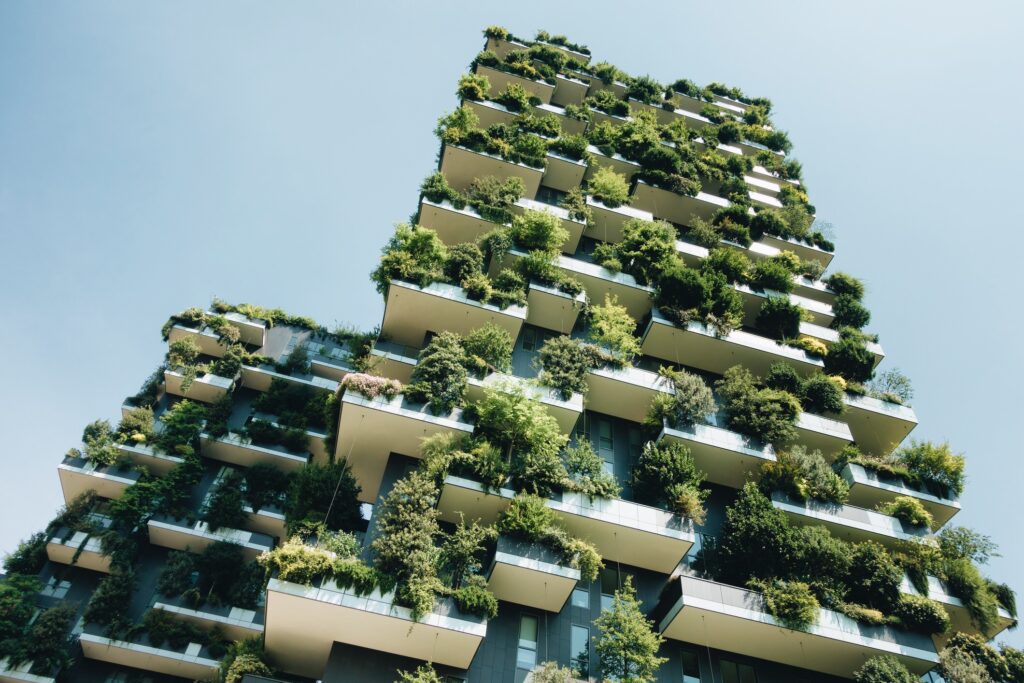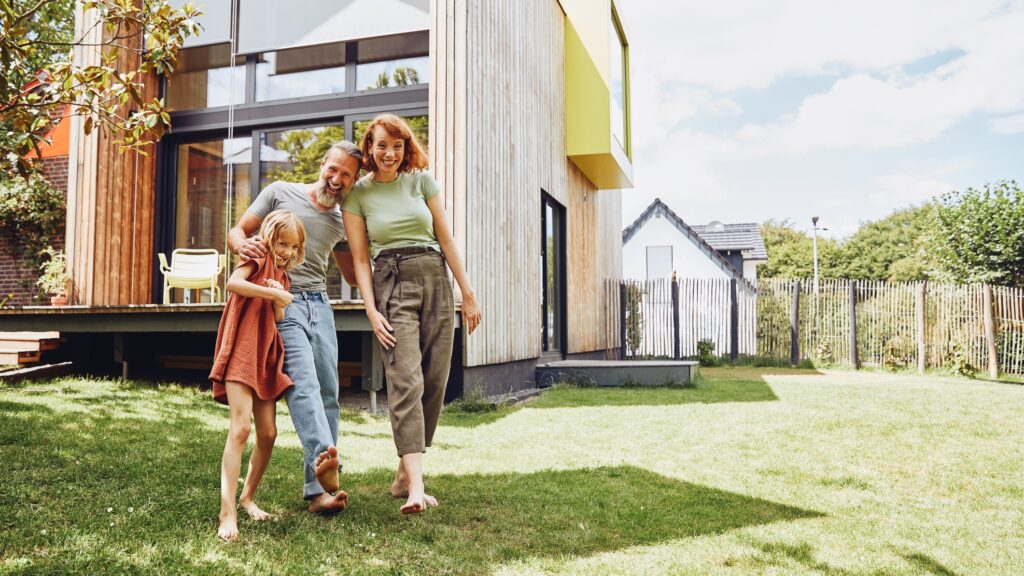Shelter is one of the most basic human concepts. We have been building permanent dwellings for around 10,000 years, since humanity first transitioned from living off the land to raising crops. That’s also around five percent of the time that humans (homo sapiens) have existed at all.
Today, many of us visit a variety of different buildings, properties, and structures every single day, including our homes and workplaces. One thing that offices, schools, banks, restaurants, supermarkets, and libraries all have in common is their impact on the environment.
They also represent important areas for intervention and improvement; both in terms of environmental impact and our overall well being. We can make these spaces and their construction more green with sustainable architecture.
What is sustainable architecture?
Any architecture that attempts to limit the negative environmental impact of building construction and operation can arguably be described as sustainable.
This may incorporate the use of recycled, recyclable, or environmentally friendly materials, or the use of renewable energy as part of the structure’s development, construction, and ongoing use.
There are a variety of regional, national, and international certifications of sustainability, including the Leadership in Energy and Environmental Design (LEED) program — developed by the U.S. Green Building Council — as well as the Building Research Establishment Environmental Assessment Method (BREEAM), Energy Star, and Australia’s Green Star, to name just a few.
Overall, the goal of green certification is to effectively assess the negative impacts of building and construction while providing the tools, support, and resources to optimize the industry.
Many sustainable rating and certification systems bring together a variety of existing sustainable practices and support the development of new, innovative, integrated solutions to ongoing issues.
Each certification scheme has slightly different priorities and criteria, and proponents of certification maintain that the standards they uphold help raise the bar for sustainable construction overall.
According to the 2017 National Green Building Adoption Index, the overall number of buildings with LEED or Energy Star certification is increasing. In 2005, under 5 percent of all businesses were certified, but by the end of 2017 that had risen to almost 40 percent.

AE
Why is sustainable architecture important?
Sustainable architecture is at the front and center of new green building and renovation projects around the world. It has the potential to significantly benefit both the humans who occupy urban spaces and the surrounding environment.
According to the UN Environment Programme (UNEP), the building and construction sector is currently responsible for 38 percent of all energy-related CO2 emissions. That’s more than the 30 percent coal-fired electricity generation contributed throughout 2018.
As of January 2021, we have just nine years left to achieve the UN’s Sustainable Development Goals (SDGs), designed to avoid the most catastrophic effects of global warming (think: rising seas, depleted fish populations, drought, and flooding).
UNEP says that if the industry is to get on track for its goal of net-zero — the balancing of emissions with their removal or elimination — by 2050, the entire value chain of the construction industry (including design, construction itself, and operations) must increase its efforts to decarbonize by at least 500 percent, a monumental undertaking.

What are sustainable building materials?
Building materials are just one of the key areas that require improvement. Modern green swaps might include high-tech sustainable concrete, such as the recyclable biocement produced by North Carolina’s Biomason, or recycled versions of traditional materials.
Some companies, such as Woodpecker in Bogota, Columbia, are combining recycled waste such as plastic and coffee husks to create new, sustainable building materials. The Dutch “Growing Pavillion” building is constructed almost entirely using mycelium (the root structure of mushrooms), while British company Chip[s] Board produces building materials out of potato waste.
More surprisingly, wood — one of the oldest building materials in existence — could be a key part of modern sustainable construction. Buildings that incorporate wood produce fewer overall emissions throughout their lifecycle and help to store carbon within city environments.

What’s the problem with concrete?
In contrast to the sustainable options listed above, many traditional post-industrial building materials are harmful. These include the obvious (asbestos) as well as the not-so-obvious, such as traditional concrete. Creating concrete involves the blending of cement with water and aggregates such as sand, crushed stone, or gravel.
Even though it is the most widely used substance on the planet after water, it is also one of the most destructive. Approximately 90 million tons of concrete are produced in the U.S. each year (for reference, that’s nearly 250 times the weight of the Empire State Building).
Concrete is responsible for nearly 10 percent of the entire world’s industrial water use, resulting in severe droughts. If the cement industry were a nation, it would be the third largest carbon dioxide emitter after China and the U.S. with 2.8 billion tons per year (though it’s worth noting that China uses at least 50 percent of the world’s concrete).
When used in cities, it exacerbates inner-city heating and is one of the key contributors to Urban Heat Island Effect. This in turn compounds the effects of global warming, causing even more intense heat waves in built-up areas, and worsening cumulative warming significantly.
Because of its huge footprint, trading concrete for sustainable alternatives — or recycling existing materials and structures — will significantly reduce the negative impact of the construction sector.

Three more benefits of sustainable architecture
Sustainable architecture represents a key opportunity to revolutionize zero carbon building by standardizing highly energy efficient structures, renewable energy, and even carbon offsetting, where required. But it also supports housing, employment, and various other benefits.
Energy efficiency
Sustainable design and construction will typically include some combination of renewable energy sources, energy-efficient lighting and heating, good use of natural light, waste reduction, water efficiency, and effective insulation.
Construction and design will also typically include a full lifecycle assessment to ensure the building retains optimal sustainability for as long as possible, not just during construction itself.
Green economic growth
In addition to its potential as a mitigator of climate change, the industry also represents an opportunity to support green economic growth through employment opportunities, as well as creating more sustainable and high-quality housing. Both of which are in high demand and low supply, particularly in the U.S. and the UK.
The buildings and construction sector currently provides up to 10 percent of national employment in the U.S. and up to 15 percent of GDP. More than finance, transportation, utilities, and public administration.
The construction industry also provides housing, mobility, water, and sanitary infrastructures. According to UNEP, it also “represents the physical context for social interactions as well as economic development at the micro-level.”
Urban Heating
Innovative architectural design and sustainable construction projects can actively reduce urban heating (which increases energy costs, pollution, and heat-related illnesses), and even produce additional renewable energy via wind and solar technology.
Person-centered design can also help improve public health by emphasizing the wellbeing of those inside and around buildings. For example, by maximizing the amount of daylight that penetrates into interiors.
The future of building: Sustainable architecture around the world
The last two decades have seen the completion of countless construction projects and several high-profile builds and renovations with sustainable features such as renewable energy generation, urban greening, composting toilets, and rainwater capture.
CopenHill
Denmark’s CopenHill combines an “urban mountain” with an ultra-modern waste-to-energy plant. Architects designed the recreational area above for sports such as skiing, snowboarding, running, hiking, and even climbing — CopenHill features the highest climbing wall in the world at 85 meters from the ground to the summit.
The plant below produces “environmentally friendly energy” by burning waste and capturing the emissions, producing enough electricity to completely power 30,000 households and an additional 72,000 central heating systems in the city of Copenhagen.
Bahrain World Trade Center
The Bahrain World Trade Center features two 50-story commercial office towers shaped much like the sails of Dhow, two-masted Arab sailing vessels. This shape helps to funnel wind into three turbines positioned on sky bridges between the towers, supplying the trade center with 11 to 15 percent of its required energy. Reflective pools below help keep the towers cool through evaporation, despite the arid desert climate.
The Pixel Building
Melbourne’s Pixel Building Project boasts a wide array of sustainable design features and became Australia’s first carbon-neutral office block on opening in 2010.
To reduce embodied carbon, the project employed low-carbon concrete and recycled building materials. It also generates all of its own power and water via onsite wind turbines and a “green roof” to process greywater.
Bullitt Center
Seattle’s Bullitt Center, known as “the greenest commercial building in the world,” is also certified as a Living Building, meaning it is a resilient, self-sufficient structure that can provide energy security for decades.
The Bullitt Center produces nearly 30 percent more energy than it requires via solar panels, making it one of the largest net-positive energy buildings worldwide. Other features include a six-story onsite composting toilet system and rainwater-to-potable water processing.
It officially opened on Earth Day 2013 and has an unprecedented 250-year lifespan (for reference, commercial buildings’ finances typically assume a 40-year lifespan). As part of its construction, the project successfully avoided any materials containing Red List chemicals.
One Central Park
Sydney, Australia’s One Central Park features two residential towers positioned at the top of a five-story shopping centre. It requires 25 percent less energy than a typical building of the same size and uses enormous, cantilevered mirrors to light the lower levels.
Perhaps most strikingly, it features a 1,000 square-meter green wall — designed by botanist Patrick Blanc, the self-proclaimed inventor of the vertical garden — incorporating 250 different species of Australian flowers and plants, which help regulate the building’s temperature.
Why sustainable architecture matters to you
Sustainable design is not limited to new buildings like the ones above, and making existing structures more energy efficient is a necessary part of reaching the sector — and the world’s — emissions targets. New housing adds just one percent to the total housing stock per year, of which only a small portion is architect-designed.
“What we have now is the majority of housing stock we will have in 2050 when we have legal national targets to reduce fossil fuel carbon emissions to near zero,” Asif Din, an ecological architect and sustainability director at the firm Perkins & Will, told LIVEKINDLY.
There are currently more than 648,114 empty residential and commercial buildings in the UK and 17 million vacant homes in the U.S. Up to 90 percent of Americans also live in under-insulated homes, while more than 19 million British houses urgently require additional insulation.
According to Din, a small additional cost at the construction stage could save a huge amount of energy overall. While utilizing empty buildings could present a solution to both the environmental impact of the construction industry and the chronic affordable housing shortages faced by the UK and many parts of the U.S.
Even materials from demolished buildings could be reclaimed and reused in new projects, where possible, such as concrete, wood, glass, and metal. But a change in industry attitudes towards materials, construction, and sustainability is required.
“We have to think of buildings as material depots,” said Dutch architect Thomas Rau, speaking to The Guardian. “Waste is simply material without an identity.”


